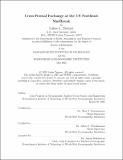Cross-Frontal Exchange at the US Northeast Shelfbreak
Author(s)
Taenzer, Lukas L.
DownloadThesis PDF (50.34Mb)
Advisor
Gawarkiewicz, Glen G.
Plueddemann, Albert J.
Terms of use
Metadata
Show full item recordAbstract
Exchange across the semipermeable US Northeast shelfbreak front is a potential driver of irreversible change to the continental shelf waters, its productive ecosystem, and economically valuable fisheries. However, cross-frontal exchange is difficult to observe directly because it is highly intermittent, non-linear, and driven by both internal frontal instability and external forcing. In this thesis, I quantify eddy-driven exchange across the US Northeast shelfbreak front and its impact on the coastal ocean, starting on seasonal timescales and moving toward individual synoptic events. For this task, I take advantage of unprecedented multi-year observations from the Ocean Observatories Initiative (OOI) Coastal Pioneer Array (2014-2022). On seasonal timescales, the buoyancy-driven shelfbreak front is persistently trapped at the shelfbreak, which supports theoretical predictions of shelfbreak frontogenesis (Chapter 2). However, exchange across the shelfbreak front leads to a significant increase in salinity on the continental shelf between spring and fall. A volume budget of the subsurface continental shelf 'cold pool', habitat of the valuable benthic ecosystem, quantifies the contribution of eddy-driven advection to the observed salinity increase and explains the seasonal cycle of watermass variability on the shelf (Chapter 3). However, the multi-year averaged cold pool watermass budget does not capture the intermittency of cross-shelfbreak eddy-fluxes on synoptic timescales. Thus, I demonstrate how individual mooring timeseries can be used to capture the statistical distribution of eddy-driven exchange by assessing cross-shelfbreak eddy-covariance fluxes of salt and heat (Chapter 4). Mean eddy-covariance fluxes align well with previous residual estimates of cross-shelfbreak exchange to close coastal watermass budgets, and just 10-20% of statistically anomalous events are responsible for half the multi-year mean flux. To characterize rapid changes in continental shelf watermass properties over short timescales, I investigate the decline of seasonal stratification due to individual weather events and identify signatures of cross-shelfbreak exchange in wind-driven destratification (Chapter 5). Altogether, this thesis extends our understanding of the characteristics, timing, and magnitude of eddy-driven exchange across the US Northeast shelfbreak front on varying timescales. This information can help to inform how large-scale, long-term trends will impact the US East Coast coastal ocean and its marine ecosystem.
Date issued
2025-05Department
Massachusetts Institute of Technology. Department of Earth, Atmospheric, and Planetary SciencesPublisher
Massachusetts Institute of Technology